|
|
|
Sort Order |
|
|
|
Items / Page
|
|
|
|
|
|
|
| Srl | Item |
| 1 |
ID:
051864
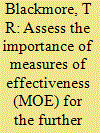

|
|
|
| 2 |
ID:
077423
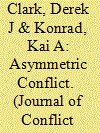

|
|
|
|
|
| Publication |
2007.
|
| Summary/Abstract |
The authors study conflict on multiple fronts. A defending player needs to successfully defend all fronts, and an attacker needs to win at only one. Multiple fronts result in a considerable disadvantage for the defending player, and even if there is a defense advantage at each of them, the payoff of the defending player is zero if the number of fronts is large. With some positive probability, in the equilibrium defending players surrender without expending effort
|
|
|
|
|
|
|
|
|
|
|
|
|
|
|
|
| 3 |
ID:
142646
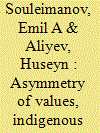

|
|
|
|
|
| Summary/Abstract |
This article fills the gap in existing scholarship on asymmetric conflict, indigenous forces, and how socio-cultural codes shape the dynamics and outcomes of conflict transformation. Specifically, it identifies three key socio-cultural values commonplace in honorific societies: retaliation, hospitality, and silence. As sources of effective pro-insurgent violent mobilisation and support from among the local population, these values provide insurgents with an asymmetric advantage over much stronger incumbents. Using the case studies of the two Russian counterinsurgencies in Chechnya, the article shows the mechanisms on the ground through which Moscow’s deployment of indigenous forces against insurgents helped to stem the tide of conflict, reversing the insurgents’ initial advantage in terms of asymmetry of values.
|
|
|
|
|
|
|
|
|
|
|
|
|
|
|
|
| 4 |
ID:
114677
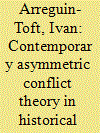

|
|
|
|
|
| Publication |
2012.
|
| Summary/Abstract |
This article offers an intellectual history of theoretical work devoted to explaining asymmetric conflict outcomes since World War II. Three factors are critical to understanding how the literature has evolved. First, the concept of "asymmetric conflict" encompasses a number of overlapping literatures, including insurgency, terrorism, counterinsurgency, and most recently, civil wars. Second, and interrelated, the field of inquiry has been unproductively divided between military and academic thinkers, with insufficient engagement between the two communities. Third, the popularity of the field of inquiry following the events of September 11, 2001, and the subsequent American-led military operations in Afghanistan (2001) and Iraq (2003) have resulted in analyses that are empirically rich, but have provided little in the way of theoretical advances. The conclusion offers an overall assessment of the field of inquiry into asymmetric conflict outcomes, suggested directions for future research, and a table of major contributors to the literature, their key questions, case universes, intended contributions, and theoretical limitations.
|
|
|
|
|
|
|
|
|
|
|
|
|
|
|
|
| 5 |
ID:
102513


|
|
|
|
|
| Publication |
2011.
|
| Summary/Abstract |
In the past few decades, planned contact interventions between groups in conflict have played an important role in attempts at improving intergroup relations and achieving peace and reconciliation. This article focuses on such reconciliation-aimed intergroup encounters between Israeli Jews and Palestinians that seek to reduce hostility and increase understanding and cooperation between the two nationalities. Like other contact interventions conducted in settings of intergroup conflict, encounters between Israeli Jews and Palestinians represent a paradoxical project: this is a project that aspires to generate equality and cooperation between groups that are embedded in a protracted asymmetrical conflict. Though existing research teaches us valuable lessons on the effectiveness of contact conducted under optimal conditions, little is said about contact between groups involved in asymmetrical protracted dispute. The goal of this analysis is to examine the evolution of reconciliation-aimed contact interventions between Israeli Jews and Palestinians in the past 20 years. The research method is qualitative, relying on ethnographic data assembled during the relevant period of time. The findings identify and trace the evolution of four major models of Jewish-Palestinian planned encounters: the Coexistence Model, the Joint Projects Model, the Confrontational Model, and the Narrative-Story-Telling Model. The strengths and limitations of each model in transforming intergroup attitudes in asymmetric conflict are discussed.
|
|
|
|
|
|
|
|
|
|
|
|
|
|
|
|
| 6 |
ID:
183696
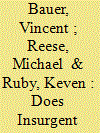

|
|
|
|
|
| Summary/Abstract |
Scholars of civil wars have long argued that non-state actors can use selective punishment to reduce collaboration with state adversaries. However, there is little systematic evidence confirming this claim, nor investigation into the mechanisms at play. In this paper, we provide such evidence from the drone war in Pakistan. Militants in Pakistan’s tribal areas engaged in a brutal counterespionage campaign with the aim of reducing collaboration with the United States. Our analysis combines a novel dataset of collaborator killings with data on drone strike outcomes. We find that strikes killed half as many militant leaders and fighters following collaborator killings and that this suppressive effect likely works by deterring spying in the future. Beyond providing an empirical confirmation of the selective punishment hypothesis, our paper suggests an unacknowledged vulnerability of the drone program to reprisals against local allies and collaborators that limits its effectiveness as a long-term tool of counterterrorism
|
|
|
|
|
|
|
|
|
|
|
|
|
|
|
|
| 7 |
ID:
157508
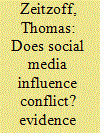

|
|
|
|
|
| Summary/Abstract |
How does international public support via social media influence conflict dynamics? To answer this question, I construct a unique, extremely disaggregated data set drawn from social media sources to examine the behavior of Israel and Hamas during the 2012 Gaza Conflict. The data set contains conflict actions and international audience behavior at the hourly level for the full 179 hours of the conflict. Notably, I also include popular support for each side from international audiences on social media. I employ a Bayesian structural vector autoregression to measure how Israel’s and Hamas’s actions respond to shifts in international public support. The main finding is that shifts in public support reduce conflict intensity, particularly for Israel. This effect is greater than the effect of the key international actors—United States, Egypt, and United Nations. The results provide an important insight into how information technology is changing the role of international audiences in conflict.
|
|
|
|
|
|
|
|
|
|
|
|
|
|
|
|
| 8 |
ID:
180671
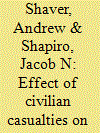

|
|
|
|
|
| Summary/Abstract |
Scholars of civil war and insurgency have long posited that insurgent organizations and their state enemies incur costs for the collateral damage they cause. We provide the first direct quantitative evidence that wartime informing to counterinsurgent forces is affected by civilian victimization. Using newly declassified data on tip flow to Coalition forces in Iraq we find that information flow goes down after government forces inadvertently kill civilians and it goes up when insurgents do so. These results confirm a relationship long posited in the theoretical literature on insurgency but never directly observed, have strong policy implications, and are consistent with a broad range of circumstantial evidence on the topic.
|
|
|
|
|
|
|
|
|
|
|
|
|
|
|
|
| 9 |
ID:
068748
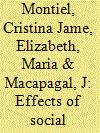

|
|
|
| 10 |
ID:
161595
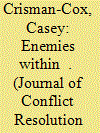

|
|
|
|
|
| Summary/Abstract |
I examine how the chief executive’s political party affects domestic terrorism within democracies. In particular, I contribute to the literature on terrorism within democracies by arguing that domestic terrorist groups prefer attacking when right-wing parties hold office. I find evidence for this claim as well as results indicating that left-wing executives are more likely to cut deals with domestic terrorist groups. These trends suggest that domestic terrorist groups attack during right-wing governance to build their reputation and reduce violence during left-wing governance to appear moderate and get a deal. These results contribute to literatures on differences between left and right parties, how political institutions affect terrorism, and differences between domestic and transnational terrorism.
|
|
|
|
|
|
|
|
|
|
|
|
|
|
|
|
| 11 |
ID:
170193
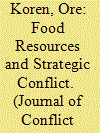

|
|
|
|
|
| Summary/Abstract |
A growing number of studies draw linkages between violent conflict and food scarcities. Yet, evidence suggests that within states, conflict revolves around food resources abundance. I develop an explanation for how the competition over food resources conditions the strategic behaviors of three actors: rebels, civilian producers who grow crops, and state forces. Using a statistical-strategic model, I validate my theory at the subnational level on new high specificity spatial data on staple crop access and productivity in Africa for the years 1998 to 2008 (and use the estimates to forecast conflict on out-of-sample data for 2009 to 2010). In line with theoretical expectations, local variations in food productivity have a positive, statistically significant, and substantive effect on the strategic behaviors of different actors. These findings suggest that the imperative for food denial as a microlevel tactic in civil war should be more seriously incorporated into the work of scholars and policy makers.
|
|
|
|
|
|
|
|
|
|
|
|
|
|
|
|
| 12 |
ID:
145903
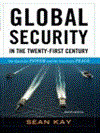

|
|
|
|
|
| Edition |
3rd ed.
|
| Publication |
Lanham, Rowman and Littlefield, 2015.
|
| Description |
viii, 417p.pbk
|
| Standard Number |
9781442248021
|
|
|
|
|
|
|
|
|
|
|
|
Copies: C:1/I:0,R:0,Q:0
Circulation
| Accession# | Call# | Current Location | Status | Policy | Location |
| 058712 | 355.033/KAY 058712 | Main | On Shelf | General | |
|
|
|
|
| 13 |
ID:
177028


|
|
|
|
|
| Summary/Abstract |
Political scientists and policy-makers have long argued that state weakness leads to civil conflict while enhancing state power helps prevent violence. Why, then, has increased state capacity worldwide recently coincided with more civil conflicts? This study argues that enhanced state presence at the sub-national level—a symptom of growing state capacity—may induce violent resistance from the established non-state powers such as local leaders and communities in the short term. Empirically, I conduct two analyses, one at the province level and the other at the ethnic group level. To measure state presence, I use accuracy of census data in the first analysis and global ground transportation data in the second analysis. Results demonstrate that increased state presence triggers civil conflict, particularly in the first five years of such increasing state presence, and this effect is stronger in remote and ethnically heterogeneous regions. Evidence also suggests that ethnic groups settled in peripheral regions are prominent resisters to state penetration. This paper thus expands prior understanding of the role of state power in civil conflicts.
|
|
|
|
|
|
|
|
|
|
|
|
|
|
|
|
| 14 |
ID:
181165
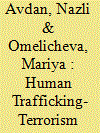

|
|
|
|
|
| Summary/Abstract |
Why do some militant organizations participate in human trafficking? We investigate this question by introducing a new dataset that records insurgent organizations’ involvement in four types of human trafficking: sexual exploitation, forced recruitment, slavery, and kidnapping. Marrying our data to the BAAD2I population of insurgent organizations, we uncover the organizational attributes related to human trafficking. We find that groups with wide alliance networks and territorial control are more likely to commit human trafficking. Organizations that are losing command of the territory and suffering rank-and-file losses are also more likely to turn to human trafficking. Our study sheds theoretical light on insurgent groups’ involvement in crime. It also contributes to the empirical scholarship on sexual violence by violent groups by studying different forms of human trafficking in both conflict and non-conflict environments. Our paper presents an original dataset and empirical analysis of insurgent groups’ human trafficking patterns.
|
|
|
|
|
|
|
|
|
|
|
|
|
|
|
|
| 15 |
ID:
154737
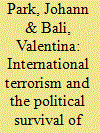

|
|
|
|
|
| Summary/Abstract |
This study examines whether transnational terrorist attacks impact the political survival of leaders. We argue that external security threats, such as those from transnational terrorist incidents, can undermine incumbent target governments by exposing foreign policy failures and damaging society’s general well-being. Yet, terrorism may not destabilize democratic governments as a result of citizens rallying around their elected leaders in threatening times. Focusing on Archigos’ survival leadership data and International Terrorism: Attributes of Terrorist Events’ terrorism data for the 1968–2004 period, we find that autocrats who experience higher instances of transnational terrorist attacks are more likely to exit power. Democrats, however, are relatively secure to the destabilizing influence of transnational terrorism.
|
|
|
|
|
|
|
|
|
|
|
|
|
|
|
|
| 16 |
ID:
157513
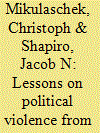

|
|
|
|
|
| Summary/Abstract |
A large literature has emerged in political science that studies the wars in Afghanistan and Iraq. This article summarizes the lessons learned from this literature, both theoretical and practical. To put this emerging knowledge base into perspective, we review findings along two dimensions of conflict: factors influencing whether states or substate groups enter into conflict in the first place and variables affecting the intensity of fighting at particular times and places once war has started. We then discuss the external validity issues entailed in learning about contemporary wars and insurgencies from research focused on the Afghanistan and Iraq wars during the period of US involvement. We close by summarizing the uniquely rich qualitative and quantitative data on these wars (both publicly available and what likely exists but has not been released) and outline potential avenues for future research.
|
|
|
|
|
|
|
|
|
|
|
|
|
|
|
|
| 17 |
ID:
132214
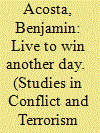

|
|
|
|
|
| Publication |
2014.
|
| Summary/Abstract |
Militant organizations pursue two common aims: to survive and to achieve the goals that define their raison d'être. Yet, elements that sustain the life spans of militant organizations are not necessarily the same components that advance the accomplishment of their core, or "outcome," goals. Further, some organizational practices, such as the use of suicide attacks, generate a tradeoff that bolsters survivability while detracting from the effective pursuit of outcome goals. This study demonstrates that three operating conditions explain variation in the duration and achievement of contemporary militant organizations: receptiveness to tradeoffs, levels of external support, and the nature of adversaries. As such, the unique effects of different operating conditions reveal why many militant organizations survive for long periods of time but only a few achieve the goals that justify their existence.
|
|
|
|
|
|
|
|
|
|
|
|
|
|
|
|
| 18 |
ID:
107897
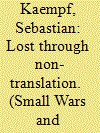

|
|
|
|
|
| Publication |
2011.
|
| Summary/Abstract |
While Carl von Clausewitz has generally been respected as one of the most profound philosophers of war, his expertise has been regarded as somewhat limited if not even irrelevant to the so-called 'new wars' of the post-Cold War world. Many scholars in international relations have claimed that 'new wars' are essentially 'post-Clausewitzian' and 'post-trinitarian' in nature, meaning that they are no longer fathomable through a Clausewitzian framework. However Clausewitz's earlier writings were nearly exclusively dedicated to guerrilla warfare, or what he called 'small wars'. These writings have been largely overlooked by many analysts of contemporary conflicts. By drawing on his rare and untranslated writings, the article uncovers a critical part of Clausewitz's expertise in asymmetric warfare and shows that, far from being irrelevant in an age where interstate warfare is increasingly being replaced by conflicts between states and semi-/non-state actors, Clausewitz's philosophical writings actually shed new light into the particular interactive dynamics generated during wars waged under conditions of asymmetry.
|
|
|
|
|
|
|
|
|
|
|
|
|
|
|
|
| 19 |
ID:
098469
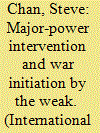

|
|
|
|
|
| Publication |
2010.
|
| Summary/Abstract |
Weak states often instigate war against the strong, sometimes repeatedly so. I explain this phenomenon by recourse to the nature of the contestants' foreign alignments. Pivotal patronage, balanced patronage, competitive patronage and one-sided patronage are offered as ideal types, and five rivalry cases are introduced to highlight the variations in the willingness and opportunity for war initiation by the weaker side and the intensity and duration of the subsequent conflict (should it occur). Whether the pertinent international system is unipolar, bipolar or multipolar distinguishes the alignment types, which in turn point to the concerns for relative gain and credible commitment that motivate the weaker side's decisions.
|
|
|
|
|
|
|
|
|
|
|
|
|
|
|
|
| 20 |
ID:
188371
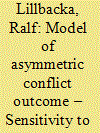

|
|
|
|
|
| Summary/Abstract |
The article assesses a model predicting outcome in counterinsurgencies based on the counterinsurgent’s exposure to external friction and strategy. Unfavorable opinions, as well as insurgents’ access to third-party support and sanctuaries, constitute sources of external friction. Strategies were categorized as mainly kinetic or population-centric. The model predicts: (1) counterinsurgents lose in contexts with high external friction regardless of strategy; (2) counterinsurgents applying a population-centric strategy win if external friction is low; (3) counterinsurgents applying a purely kinetic strategy win if external friction is low only by obtaining distinct tactical superiority. The model correctly predicted 27 of 30 examined cases.
|
|
|
|
|
|
|
|
|
|
|
|
|
|
|
|
|
|
|
|
|